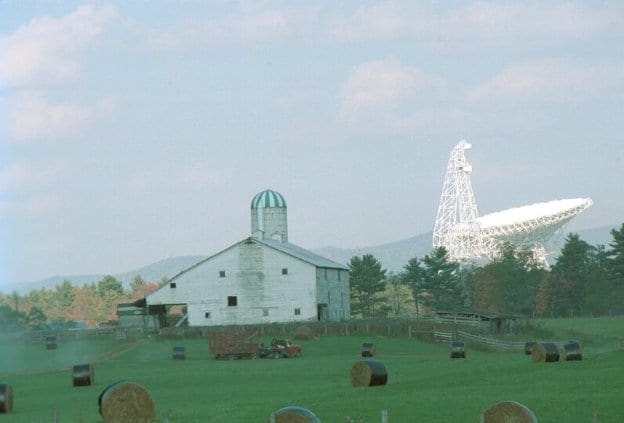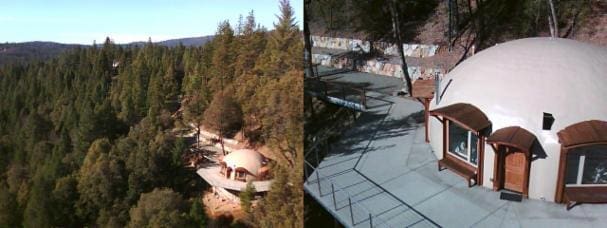Imagine life without cell phones or WiFi. There’d be no text messages, no checking Facebook on your daily commute, no selfies, no GPS. For the residents of Green Bank, West Virginia, that’s the reality. Welcome to the world of EMF-free zones – communities where you can detox from the harmful negative health effects of exposure to electromagnetic radiationElectromagnetic radiation refers to the waves of the electromagnetic field, propagating through space, carrying electromagnetic radiant energy. It includes a wide range of electromagnetic waves, from very long radio waves....
What is an EMF-Free Zone
All modern electronic and wireless devices emit a form of radiation"Radiation" in the context of Electromagnetic Fields (EMF) refers to the process by which energy is emitted and transmitted through space or a material medium in the form of electromagnetic... called electromagnetic radiation (or EMF).
An EMF-free zone is a designated area where such emissions are strongly restricted or impermissible.
So, for example, in an EMF-free zone, you will likely have no cell service and no WiFi. In many such zones, even microwave ovens are banned. And in some, there will be little to no power"Power" in a scientific context refers to the rate at which work is done or energy is transferred. In simpler terms, it's how fast something is using energy. For example,... grid infrastructure (so there will be no power lines, which are a significant source of EMF radiation).
Why Live in an EMF-Free Zone?
Most of us can’t even imagine living in a place with no EMF sources. Modern technology is so deeply engraved into our lives that life seems almost impossible without it. But for people with extreme electromagnetic hypersensitivity, these zones are the only places where they can live in comfort.
So, what is electromagnetic hypersensitivity?

Want to Slash Your EMF Health Risks?
Want to Slash Your EMF Health Risks?
Good! Learn the one small change you should make right now.
Electromagnetic Hypersensitivity
Electromagnetic hypersensitivity (or EHS) is a condition that causes one’s body to react to EMF radiation as it would do to an allergen. This can result from a compromised immune system or some other underlying conditions.
Whatever the cause, it’s uncomfortable, and the World Health Organization (WHO) agrees. They say, “EHS is a real and sometimes a disabling problem for the affected persons.”
Symptoms of EHS include “headache, fatigue, stress, sleep disturbances, skin prickling, burning sensations and rashes, pain and ache in muscles and many other health problems.”
In more extreme cases, the effects of EHS can be debilitating, preventing the sufferer from living a normal life, working, or even going outside.
Driving past a mobile phone tower might set someone off; others might be in constant agony from the abundance of WiFi signals bouncing around in the air.
There’s no standard cause or symptoms, making diagnosis difficult.
The World is Recognizing EHS
We don’t have a diagnostics tool to detect EHS yet. This is why most of the world doesn’t formally recognize EHS as a medical condition.
Austria stands alone as the only country with written guidelines for the diagnosis and treatment of EHS. And in Sweden, while no such policies exist, EHS is “an officially fully recognized functional impairment.”
But this situation is changing.
For example, the Women’s College in Toronto now offers an electrohypersensitivity diagnosis to patients and a clinic dedicated to addressing it.
And in 2015, a French court granted disability coverage to a woman who suffers from EHS, while in Sweden, some municipalities grant disability insurance to EHS sufferers.
What Can You Do If You Have EHS?
Like with most other health problems, the actions you’ll need to take depend on the severity of your condition.
Take fever, for example. Experts consider a body temperature of around 100°F (37°C) as a low-grade fever. At this point, in most cases, you won’t need to visit a doctor. Simple over-the-counter (OTC) medications can make it go away.
However, if your temperature is above 103°F (39°C), that’s a sign you need to give your doctor a visit immediately. And you’d be treated in a hospital, instead of at home, waiting for the fever to go away.
Apply the fever example to EHS, and you know exactly when to take strict action. If you have mild symptoms, you can alleviate them by simply making minor changes in your life, like:
- Turning off your WiFi router at night
- Not carrying your cell phone in your pocket
- Keeping your phone away while you sleep
- Using EMF shieldingEMF shielding refers to the practice of reducing the electromagnetic field (EMF) exposure in a particular area by blocking or altering the electromagnetic waves with barriers made of conductive or... products like the SYB Phone Pouch, SYB 5G Phone Shield, and the SYB Laptop Pad.
However, if the symptoms are seemingly uncontrollable and they’re reducing your quality of life, you may need to find an escape.
The people who do that are called EMF refugees—people who are so sensitive to EMF radiation that they must escape it or suffer debilitating, life-altering symptoms.
And for those EMF refugees, we have the EMF-free zones. These places offer an escape from the bombardment of EMF radiation we’re all exposed to every hour of every day in modern society.
What are the Types of EMF-Free Zones?
Broadly speaking, there are two types of EMF-free zones.
Radio Quiet Zones
All wireless devices use EMF radiation to communicate. These devices send and receive signals in what is known as the radio frequencyRadio Frequency (or RF), a subset of EMF, encompasses electromagnetic wave frequencies ranging from about 3 kilohertz (kHz) to 300 gigahertz (GHz). These frequencies are extensively used in modern wireless... (or RF) range of the EMF spectrum.
A radio quiet zone is an area where such radio frequency"Frequency" in the context of electricity, Electromagnetic Fields (EMF), and wireless communication, can be thought of as the number of times something happens in a second. Specifically, it refers to... transmissions are forbidden (or severely restricted) by law. So, wireless technology is effectively prohibited.
Why would the law prohibit radio signals? Well, in the case of the United States Radio Quiet Zone, it was created in 1958 to protect an incredibly sensitive telescope from interference.
This telescope is in the Green Bank Observatory in West Virginia. It is the world’s largest fully steerable radio telescope – it’s two acres large and as tall as the Washington Monument. And it’s incredibly sensitive. This device can detect a radio signal from 13 billion light-years away.
This telescope can’t have any interference from modern technology like cell phones, WiFi routers, or even microwave ovens. This is why Green Bank heavily restricts wireless technology.
Other Radio Quiet Zones Around the World
Green Bank, WV, may be the most widely known radio quiet zone – especially in the United States – but there are other extremely sensitive telescopes around the world that are protected by radio quiet zones, including:
- The Arecibo Observatory in Puerto Rico
- The Square Kilometer Array in South Africa
- The Atacama Large Millimeter Array in Chile
- The Australian Radio Quiet Zone WA in Australia
- The Dominion Radio Astrophysical Observatory in Canada
- The Five-hundred-meter Aperture Spherical Telescope in China
- The Institute for Radio Astronomy in the Millimeter Range in Spain
- The Itapetinga Radio Observatory in Brazil
- The Large Millimeter Telescope in Mexico
The Pushchino Radio Astronomy Observatory, Russia
White Zones, or Quiet Zones
So, a radio quiet zone is a type of EMF-free zone that has been established by law. But there are other EMF-free zones as well. These are called white zones (sometimes just “quiet zones”).
In white zones, EMF emissions are regulated not by law but by the market.
White zones are areas without cell service. They get their name from the color used on maps published by cell phone providers to designate areas without service.
And because these white zones have no cell service, they have orders of magnitude less EMF in the environment.
The Top 4 EMF-Free Zones – Updated 2020
Here are the top four EMF-free zones around the world, that you can explore.
1) United States National Radio Quiet Zone – Green Bank, West Virginia
As mentioned above, the United States designated this area as a radio quiet zone in 1958 to protect the very sensitive telescope housed in the observatory there. It is large – 13,000 square miles – and technically spans three states, West Virginia, Virginia, and Maryland.
As a result, as EHS has become more widespread, Green Bank has become a sanctuary for those who suffer from electromagnetic sensitivity. There are currently about 150 full-time residents, many of whom live there because of the lack of EMF.
One resident, Diane Schou, moved to Green Bank in 2007 because of her constant headaches. She explained to Slate that life isn’t perfect here. “There’s no grocery store, no restaurants, no hospital nearby… But here, at least, I’m healthy. I can do things. I’m not in bed with a headache all the time.”
To learn more about Green Bank, you can watch this video created by National Geographic:
2) Snowflake EHS/MCS Community – Snowflake, Arizona
The Snowflake Community in Arizona was founded in 1988 and is one of the oldest refuges available for those who suffer from EHS.
Snowflake wasn’t designed just for those with EHS. They describe themselves as a community for those suffering from environmental illnesses (or EI), including EHS, but also other conditions such as multiple chemical sensitivity (or MCS).
Snowflake features a variety of different residents. Single and married. Young and old. Some are well off, and some just get by. And some of the homes are fancy, while others are basic. Some homes are shielded against EMF radiation, and others are not.
Snowflake is in a white zone. There are two cell towers in that town, both with very weak signals. You can visit EI Wellspring for more information on Snowflake and other EI communities in Arizona.
3) Zurich House, Swiss Healthy Living Foundation – Zurich, Switzerland
Christian Schifferle suffered from multiple environmental sensitivities, which led him to live in a primitive steel hut in the mountains outside of Zurich for twenty years.
In 2008, he co-founded the organization Swiss Healthy Life, and the city of Zurich donated a parking lot. Once he raised sufficient funding, Zurich House was created – designed from the groundIn the context of electricity, "ground" or "earthing" refers to a reference point in an electrical circuit from which voltages are measured, a common return path for electric current, or... up as a safe space for those with environmental sensitivities (including EHS) to live.
This building is custom-made for those hypersensitive to several different environmental pollutants. These include perfumes and smoke, as well as microwave radiationMicrowave radiation is a form of electromagnetic radiation with wavelengths ranging from one meter to one millimeter; with frequencies between 300 MHz (0.3 GHz) and 300 GHz. This type of.... Among other considerations, the building is constructed with radiation-shielded insulationIn the context of electromagnetic radiation, the term 'insulation' refers to a material or substance's ability to impede or resist the transmission or propagation of electromagnetic waves, including electric and... – in effect, the entire building is a Faraday cage.
Many occupants suffer from electromagnetic hypersensitivity as well as other environmental sensitivities. “It makes me weak, anxious, I can’t breathe, my lungs hurt, and I get dizzy,” says Schifferle, who suffers from both conditions.
While living in the building will not cure Schifferle or others, it aims to make daily life more comfortable for people whose conditions have often left them isolated and unable to hold jobs.
4) Australian Radio Quiet Zone Western Australia – Murchison, Australia
The Australian Radio Quiet Zone in Western Australia is similar to the radio quiet zone in Green Bank. This one, however, is the largest radio quiet zone on earth, with an outer zone reaching 93 miles (150 km) away from the observatory!
The Top 4 EMF Detox Retreats – Updated 2020
Moving to an EMF-free zone may be an option to consider for those suffering from EHS. However, there are other options available. Maybe you just want to test out whether living in an EMF-free zone improves your health before committing to moving to one. Or perhaps you just want to detox from EMF at a retreat or spa for a nice vacation.
In either case, there are plenty of options for EMF detoxing and testing out an EMF-free lifestyle. Here are some of the top EMF detox options.
1) The Quiet Dome – Grass Valley, California
The Quiet Dome is a rental home located on 11 acres inside a white zone in the Sierra Nevada mountains. Miles away from the nearest WiFi and cell service, the Quiet Dome is a peaceful retreat surrounded by nature.
And it’s available for short-term rentals.
2) Harbin Hot Springs, California
The Harbin Hot Springs, outside of San Francisco, California, offers guests a spiritual retreat on 1,700 acres of meadows, hills, canyons, and creeks. There are hot, warm, and cool pools, a fantastic natural foods menu, and of course, no WiFi or cell phones allowed.
3) Rose Hill Off-Grid Farm in Horsefly, BC
The Rose Hill Off-Grid Farm sits on 162 acres in Canada’s Cariboo Region of British Columbia. And it is genuinely off-grid: there’s no cell service or WiFi, and the water comes from a well powered by solar electricity.
Short-term rentals are available on Airbnb.
4) Beacon Bank Farm in Staffordshire, England
Beacon Bank Farm is a meditation and martial arts retreat in Staffordshire, England. There is no WiFi, and guests are requested to keep their cell phones off during their stay.
Living in an EMF-Free Zone: CNN Deep Dive Into Greenbank, West Virginia
Now, after all that explanation of EMF-free zones, you might be wondering what it’s actually like to live in one. Fortunately, Dr. Sanjay Gupta on CNN explored that very topic in a three-part series exploring the research behind electromagnetic sensitivity, the dangers of EMF exposure, and more.
If you get your news reports from CNN, you might be familiar with Dr. Sanjay Gupta. The US-born neurosurgeon and medical correspondent has already won multiple Emmy Awards for his work. His CNN segment “Vital Signs” explores health stories from all around the world. One issue that Dr. Gupta reports for CNN is the health dangers of wireless EMF radiation.
Here are the three parts of his CNN report.
Part One: Welcome to the National Quiet Zone
Part One of CNN’s series takes us inside the radio quiet zone of Green Bank, West Virginia. As we explained above, Green Bank is home to a large, highly sensitive telescope. To prevent interference with the telescope, all types of wireless technology and radio signals are banned by law within the zone.
The quiet zone is also home to a small community of people who suffer from electromagnetic hypersensitivity (EHS). Dr. Gupta interviews one Green Bank resident who began suffering from headaches, fatigue, and skin rashes after a cell phone tower was erected near her Iowa home. When she relocated to Green Bank, her symptoms disappeared.
The symptoms of EHS vary from person to person and are difficult to confirm or diagnose. That’s why some people still question its existence.
Dr. Gupta seeks out an expert opinion and interviews David Carpenter, Director of the Institute for Health and the Environment at the University of Albany.
At the start of his career, Carpenter “did not believe that EHS was a real medical condition.” His work over the years, says CNN, has changed his mind.
Carpenter refers to studies exploring the link between childhood leukemia and EMF radiation from household wiring. “I thought that was just ludicrous and nonsense,” he says. “And then we supported studies that confirmed those observations.”
While Carpenter agrees that it’s necessary to be skeptical, it’s also important to “look at the evidence and take the evidence seriously.” He says: “While the evidence is still building, I’m convinced it’s a real disease.”

Part Two: Reducing Wireless Exposure
“As the world becomes more connected,” asks CNN, “how can you reduce your exposure to electromagnetic fields?”
The second video by Dr. Sanjay Gupta doesn’t ask if we should try and minimize EMF exposure — that’s already a given. Instead, it jumps into why and how.
The video opens with research into cell phone use and health. In 2011, it notes, the World Health Organization classified radiofrequency electromagnetic fields as “possibly carcinogenic to humans” based on the increased risk of brain cancer from wireless phone use.
“Reduce your exposures wherever possible,” says Joel Moskowitz, Director of the Center for Family and Community Health at UC Berkeley. He singles out measures like using wired internet connections, landline phones, and headsets. “Around one in 250 people will get brain cancer over their lifetime. What we’re finding with 10 years of cell phone use is a doubling of risk.”
Dr. Gupta heads back to Green Bank, where EHS sufferers have gathered to reduce their own wireless exposure. The experiences of sufferers like Dafna Tachover, a telecommunications officer in the Israeli army, and Melissa Chalmers, a commercial airline pilot, are similar despite their different backgrounds. All experienced debilitating symptoms in daily life that subsided or disappeared after moving to Green Bank.
Researchers have yet to find a definitive link between EMFs and electromagnetic hypersensitivity symptoms. But, the program notes that establishing such cause-and-effect relationships takes decades, and technology moves faster than research can keep up with.

Part Three: Living in the National Quiet Zone
Leo Halepli has been living in Green Bank on and off for three years. Originally from Turkey, he’s a management consultant by trade and a self-confessed tech geek.
Despite his love of computers, Halepli developed EHS symptoms like muscle tenseness, gastrointestinal issues, and fatigue. After years of visiting doctors and psychologists to no avail, Halepli, willing to try just about anything, moved to the EMF-free zone of Green Bank.
“When I was driving into the zone, I felt a sense of relief,” he says. His symptoms quickly subsided. Halepli, like others, has also found that the more time he spends in Green Bank, the better he can cope with electromagnetic radiation when exposed. “The longer he spends here,” explains Dr. Gupta, “the more time he can spend away—in small doses.”
Halepli’s story is yet another that suggests, at least anecdotally, that the health effects of electromagnetic fields have not yet been fully realized or documented.
“While the scientific research regarding EHS continues,” concludes Dr. Gupta, “one thing is for sure: disconnecting with our devices, and reconnecting to each other, can’t hurt.”

Limitations of EMF-Free Zones
EMF-free zones are a fantastic option for many – and a lifesaver for those with EHS. They exist because there are still places on earth that remain largely untouched by EMF emissions.
While the number of EMF detox options will almost certainly increase in the coming years, along with EMF awareness and the exponential growth in EMF-emitting technology, another trend puts this at risk.
Companies like SpaceX, Google, and Facebook are surrounding the planet with low-orbit communications satellites to bring wireless internet to every inch of the planet.
StarLink
SpaceX’s satellite internet project is called StarLink. The first test satellites were launched in 2018. Then 120 more were launched in 2019. And StarLink plans to launch 12,000 low-earth orbit satellites in the coming years. By comparison, there are only 2,000 such satellites today, and only 9,000 have ever been launched across human history.
Once these companies get their satellites up in orbit, there will be about 50,000 of these low-earth orbiters, emitting enough EMF to provide broadband internet to every inch of the planet.
With just 120 satellites in orbit, astronomers worldwide are complaining that these new satellites are interfering with their work.
It is unknown how much EMF exposure will result on the ground from these new satellites from StarLink and many other providers.
Final Thoughts
If these companies do as promised and cover every inch of the planet with high-speed internet, then EMF levels will obviously increase. This will jeopardize the ability of EMF-free zones to serve as a safe haven for the electrohypersensitive and those who just want a real detox from electrosmog.
In the meantime, the EMF-free zones detailed above will continue to be a haven for EMF refugees. And beyond those, you can still take measures to protect yourself from EMF radiation – wherever you are and in all aspects of your daily life – by following some simple healthy living tips and guidelines.












